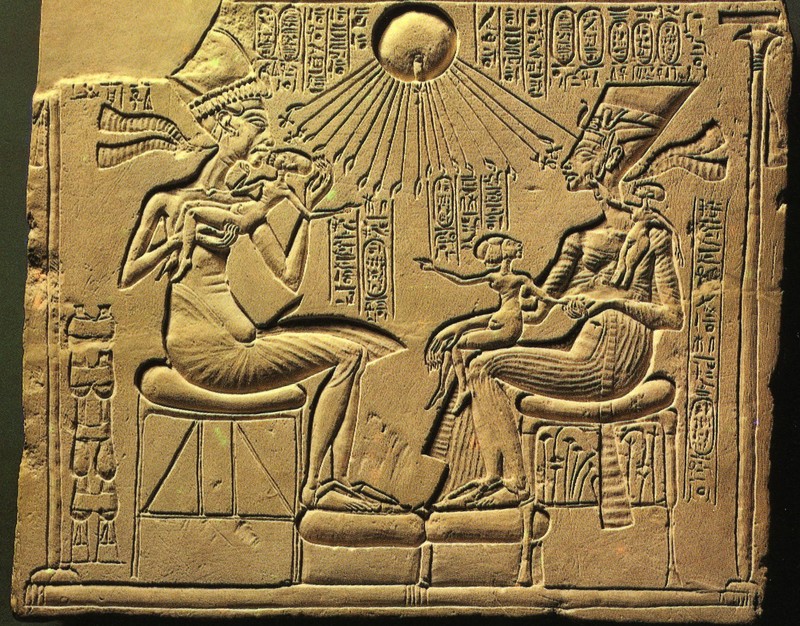Akhenaten and Nefertiti Stele
Title
Akhenaten and Nefertiti Stele
Date
18th Dynasty (New Kingdom), ca. 1345 BCE
Artist or Workshop
Unknown
Materials
Limestone
Height of the work
33.5 cm tall
Provenience
Egypt, Amarna, a private residence
Current Location
Staatliche Museum zu Berlin, Ägyptisches Abteilung, Berlin, Germany
Sitter Biography
Akhenaten, originally Amenhotep IV, was son of the pharaoh, Amenhotep III, and the father of Tutankhamun. During his reign as pharaoh in the 18th Dynasty (ca. 1350-1336 BCE), he instituted a religious and artistic overhaul. His new religion shifted worship from the pantheon of Egyptian gods to the worship of Aten, the sun disc. The royal family, too, was revered for the unique ability to access Aten. Even so, after his death, the Egyptians restored their original religion, and abandoned the worship of Aten. After his death, his successors defaced and destroyed many of his portraits.
Description and Significance
Description:
This stele is emblematic of Amarna period art: the figures are portrayed with elongated skulls, thin necks, slim arms, distended bellies, and spindly calves. Akhenaten is seated on the left; Nefertiti, on the right. Akhenaten and Nefertiti wear some traditional markers of Egyptian power: particularly their crowns and the uraeus found on each. Akhenaten lacks the traditional false beard or nemes, headdress in this scene though. In addition to the royal couple, three of their daughters are present as well, playfully interacting with their parents. Akhenaten tenderly lifts one daughter up to give her a kiss, while Nefertiti holds two daughters: one on her lap, and another on her shoulder. At the top of the panel, the god Aten is represented as the sun disc. From the disc, Aten emits rays of light with ankhs, the life symbol, at their ends.
Significance:
This stele presents the royal family in an intimate, private setting. At the same time, the stele is steeped with religious symbolism, and is intended to facilitate the transition from traditional Egyptian religion to Akhenaten’s own. Given the domestic context of this piece, it would have been in the hands of a high-class citizen, rather than Akhenaten or Nefertiti themselves. The pharaoh Akhenaten and Nefertiti are portrayed together in relaxed poses, showing tender affection to their daughters. This likely would have an endearing affect on their intended audience, yet at the same time, the stele reinforces the importance of the royal family, not only as leaders, but as the living connection to the god, Aten. It is only through Akhenaten that the god can be accessed, which has led to speculation that the Amarna revolution may have in response to the increasingly powerful high priests within Egyptian society.
This stele is emblematic of Amarna period art: the figures are portrayed with elongated skulls, thin necks, slim arms, distended bellies, and spindly calves. Akhenaten is seated on the left; Nefertiti, on the right. Akhenaten and Nefertiti wear some traditional markers of Egyptian power: particularly their crowns and the uraeus found on each. Akhenaten lacks the traditional false beard or nemes, headdress in this scene though. In addition to the royal couple, three of their daughters are present as well, playfully interacting with their parents. Akhenaten tenderly lifts one daughter up to give her a kiss, while Nefertiti holds two daughters: one on her lap, and another on her shoulder. At the top of the panel, the god Aten is represented as the sun disc. From the disc, Aten emits rays of light with ankhs, the life symbol, at their ends.
Significance:
This stele presents the royal family in an intimate, private setting. At the same time, the stele is steeped with religious symbolism, and is intended to facilitate the transition from traditional Egyptian religion to Akhenaten’s own. Given the domestic context of this piece, it would have been in the hands of a high-class citizen, rather than Akhenaten or Nefertiti themselves. The pharaoh Akhenaten and Nefertiti are portrayed together in relaxed poses, showing tender affection to their daughters. This likely would have an endearing affect on their intended audience, yet at the same time, the stele reinforces the importance of the royal family, not only as leaders, but as the living connection to the god, Aten. It is only through Akhenaten that the god can be accessed, which has led to speculation that the Amarna revolution may have in response to the increasingly powerful high priests within Egyptian society.
References
Breckenridge, James D. 1968. Likeness; a Conceptual History of Ancient Portraiture. Evanston Ill: Northwestern University Press. 59-61.
Wildung, Dietrich, Fabian Reiter, Olivia Zorn, and Ägyptisches Museum (Staatliche Museen zu Berlin). 2010. Egyptian Museum and Papyrus Collection, Berlin : 100 Masterpieces. London: Scala. 81-83.
Wildung, Dietrich, Fabian Reiter, Olivia Zorn, and Ägyptisches Museum (Staatliche Museen zu Berlin). 2010. Egyptian Museum and Papyrus Collection, Berlin : 100 Masterpieces. London: Scala. 81-83.
Contributor
Jonathan Clark
Citation
Unknown, “Akhenaten and Nefertiti Stele,” Digital Portrait "Basket" - ARTH488A - "Ancient Mediterranean Portraiture", accessed June 5, 2025, https://classicalchopped2.artinterp.org/omeka/items/show/56.
Item Relations
This item has no relations.

